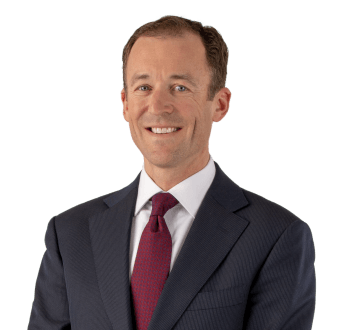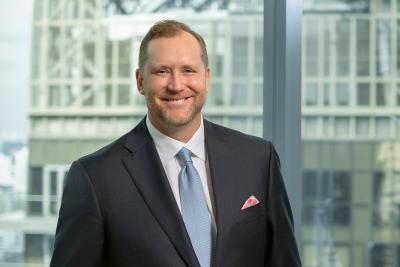The Time is Now – Yield & Opportunity off the Beaten Track in Janus Henderson’s Multi-Sector Income Fund

Phil Gronniger of Janus Henderson Investors
Nov 17, 2023
Phil Gronniger, Client Portfolio Manager for the Balanced and Fixed Income Strategies at Janus Henderson Investors is on a mission to convert investors to what he believes is a strategy to obtain income while avoiding being over-reliant to short-term yields, and to diversify over the entire fixed-income universe. In the current environment of rates staying high for longer (but certainly not forever), he advocates the Janus Henderson Multi-Sector Income Fund for the professional wealth management community and their clients, as it offers relatively attractive levels of yields, enhanced by balancing exposures to traditional fixed income sector with allocations to Securitized assets, such as MBS (mostly Agency and also some non-Agency), AAA CLOs, CMBS, and high-quality ABS. Phil has been on a roadshow across Asia to promote the fund and in early November hosted a group of gatekeepers, CIOs and family office leaders in a private, bespoke Hubbis event in Singapore, following that up with a lively presentation and detailed slide show at the Hubbis Investment Management Forum.
By way of background, Phil is a Client Portfolio Manager for the Balanced and fixed income strategies at Janus Henderson Investors, a position he has held since 2014. Before this, he was a senior product manager for the Balanced and fixed income strategies with the firm since 2010. Prior to that, he was a vice president and portfolio manager for Financial Counselors, Inc. where he managed fixed income strategies for institutional clients and large-cap growth portfolios for private clients since 2007.
He cut his teeth pre-GFC as an analyst as well as a fixed income and equity trader there from 1998 onwards, having graduated from the University of Missouri in Kansas City with a BSc in management and business. He holds the Chartered Financial Analyst designation and has now built up some 25 years of financial industry experience.
The vehicle for income and diversification
The Janus Henderson Multi-Sector Income Fund has as its stated aim to produce high income with the potential for some capital growth over the long term. The Fund invests at least 70% of its assets in US issuers in a global multi-sector portfolio of debt securities of any quality, including asset-backed and mortgage-backed securities, high-yield securities, including non-investment grade or unrated securities, issued by governments or companies.
The UCITS Fund dates to 2019 and has total net assets of USD240.4 million as of 31 September 2023, while the strategy was launched almost 10-years ago. At that date, it held 342 debt issues with a weighted average maturity of 5.95 years and a maturity of 4.45 years, and a ‘yield to worst’ of 9.08%.
Some 95%-plus of exposures are to North America, compared to 93.25% to Bloomberg US Aggregate Bond Index. Just over 29% is invested in Agency MBS, somewhat over 18% in High Yield (the Index is a mere 0.01%), nearly 15% in Non-Agency MBS, 13% in CLOs, and 11.4% in IG corporate paper (while the Index allocates over 24%). The balance is spread amongst CMBS, ABS, Bank Loans and others.
Talking about their significant position in Agency MBS today, Phil points to the zero default risk as Agency MBS are pools of securitized residential mortgage loans that are issued and guaranteed by US government agencies) and theoretically zero prepayment risk as 80% of US mortgages are at rates below or around 4.5% when current refinancing rates are circa 7.5%.
Multi-sector for diversified access
Janus Henderson’s experts believe that as investors consider how to diversify their core bond allocations, a multisector approach should result in better risk-adjusted returns over the long term. They maintain that an active approach that incorporates multiple sectors may provide better exposure to the broad fixed-income universe than a passive index. Multi-sector strategies may also allow investors to better manage and balance key risk factors relative to a benchmark index.
A vital key is balancing yield and duration. Short-term interest rates have risen far more than intermediate and long-term rates in the current tightening cycle. The resulting inverted yield curve has presented investors with the rare opportunity to earn higher yields with less interest-rate risk.
Picking the best balance of safety and return
In the JH view, AAA rated collateralized loan obligations (CLOs) currently offer a compelling option to access higher yields within the short-duration universe. And investors should consider agency and non-agency MBS alongside AAA CLO allocations to fine-tune their overall portfolio duration.
Phil explained that the Bloomberg US Aggregate Bond Index is essentially 80% duration risk, whereas the ‘beauty’ behind a true non-constrained multi-sector strategy is the fact that the fund can go anywhere within the fixed income universe, as indicated in the weightings above, which includes Sovereign, Corporate IG, Corporate HY as well as all the other key sub-sectors.
Freedom of expression
“These are oftentimes overlooked but offer significant opportunity for diversification and return, allowing investors to obtain a better mix of exposure to risk factors, rather than just duration,” he explained. “Securitized assets are becoming a key component of the fixed-income universe that add to diversity and improve returns while mitigating risks.”
Using this freedom of expression to allocate as the fund managers see fit, they are, Phil reports, achieving their three core missions. First, they want to deliver ‘high yield-like’ returns, but with much less volatility over time. Second, the fund aims to provide significant yield & deliver an attractive level of distributed income. Third, the fund aims to be nimble and allocate dynamically across the entire US fixed-income universe, including plentiful securitized assets. “We believe we have best-in-class skills and expertise in those assets,” he stated.
Delivering the message in Asia
Addressing the reality that securitized assets are less well known or understood in Asia these days than in the US, partly because they tend to be US-centric assets/structures, Phil said therein lies an opportunity.
“While Corporate Bonds are trading tight, spreads on securitized assets are trading wide, hence offering higher returns while also providing more buffer in case of a negative surprise on the macroeconomic/growth side,” he explained. “Simply, we like Agency MBS primarily, AAA-rated CLOs, non-Agency MBS, ABS, and some CMBS.”
Phil elaborated further on the key reasons why Janus Henderson is positive on Agency MBS today. First, Agency MBS are widely considered as having virtually zero credit risk, as these are issued by government agencies which are backed by the “full faith and credit” of the US government, just like US Treasury bonds. Second, refinancing risk –one of the main risks associated with Agency MBS – is also far removed today, as more than 80% of mortgages in the U.S. were issued at rates at or below 4.5%, hence removing the economic incentive to refinance given current levels (more than 7.5% at present). Finally, agency MBS have seen exogenous technical shock occur this year, as U.S. regional banks had to sell a lot of the MBS that they had on their balance sheets during the banking crisis in Q1. This resulted in a temporary oversupply of Agency MBS to the market – and therefore wider spreads – which Janus Henderson believes is temporary and hence, currently offers an attractive entry point for savvy investors.
With regards to CLOs, Phil also clarified that, while investors might sometimes be confused with all the acronyms prevalent to the securitized universe, it is key to remember that CLOs (based on loans issued by corporations) have nothing in common with CDOs (which were built on sub-prime mortgages which should have never been issued in the first place). As such, he reminded the audience that there has never been a default of a AAA-rated CLO since the asset class took off 30 years ago. Phil also reminded the audience that during times of economic stress, CLO structures are designed so that cashflows are diverted from the lower-rated tranches towards the higher-rated AAA tranches first, which results in reducing the risk for AAA tranches and leads to deleveraging of the overall structure.
Longer does not mean forever
In today’s environment where short-term yields (including cash) are so appealing compared to the past 12-15 years, and also relative to spreads/yields on longer-dated obligations, investors might be perfectly justified in taking little duration exposure. But Phil points out that higher for longer does not mean higher forever, and that this is an ideal time to be locking in attractive yield for the longer-term.
“It is something we reconcile with our approach called ‘balancing the barbell between yield and duration’, he reported. “On the one hand, short-term yields will drop sharply once the US Federal Reserve cuts, and this will happen sooner or later. Accordingly, investors need to consider how to diversify their exposure on the short-end of the curve, by looking for example at AAA-CLOs as one way to improve returns.”
Build the new roof when the sun shines!
On the other hand, investors also know the old adage that the roof needs fixing when it is sunny, meaning that investors should progressively start to add back to duration. “There are many ways to do that, but in case investors are unsure, allocating to a Multi-Sector Income strategy is, we believe, a good way to achieve a smart blend of duration and spread risk allocation.”
One of the key areas, Phil explained, is the CLO space, and particularly AAA-rated CLOs. In fact, Janus Henderson operates its recently-turned-3-year-old AAA CLO ETF, which has garnered more than USD4.5 billion in AUM to date and dominates the space
CLOs – a versatile asset class
He articulated the appeals of the CLO market. He said CLOs are floating rate products, meaning that they don’t get negatively impacted during rising rate cycles, which effectively means that they offer close to zero duration. They offer a significant pick-up in yield compared to cash & money market funds. They offer a zero default record in AAA-rated CLOs in the past 30 years (including through the GFC), and they present virtually zero correlation to any asset class except bank loans.
“For all of these reasons, AAA-rated CLOs are a great way to diversify away from cash and money markets and generate higher returns for investors,” he concluded. “Hence that’s no surprise that they’ve returned more than 6.5% YTD, an annual equivalent of circa 8.5%, and in an almost perfect straight line.”
Stability, integrity and fundamental analysis
Phil was asked what differentiates Janus Henderson’s Multi-Sector Income Fund from any competitors. He explained that the same three portfolio managers had overseen the fund since the inception of the strategy 10 years ago, which is quite unique. He said there is no home bias for the fund, with each manager contributing to a different aspect of the fund (Securitized Assets, High Yield, and Credit Research), which makes their actions more nimble and faster.
He explained that the selection of securities was bottom-up, which reflects JH’s history and DNA as a fundamental-driven investment house.
“We apply the same discipline in Fixed income selection as in our highly-successful Equity strategies,” he told guests. “We are also big enough to matter, but small enough to be agile, and that is true for this fund; it means that we can really focus on our best-idea names in the fund and don’t need to just buy some assets because of the size of the fund.”
Freedom to allocate
Additionally, he commented that because of their security selection focus and their size, they are very credible when talking about adding alpha via security selection. “That might not be the case with much larger managers,” he said. “As such, our strategy has generally acted as a solid complement to other multi-sector funds, which might be more ‘top-down’ heavy. Finally, our significant weighting to securitization is a key differentiating factor.”
The results speak for themselves
He explained that the result of all this is a yield-to-worst of 9.08% compared with the benchmark of 5.39% and distribution of 5.9%.
Phil then highlighted the success of the Janus Henderson Fixed income platform. “Janus Henderson is perhaps best known for equities, but actually, we have been running Fixed income portfolios for a long time and manage a pretty credible USD83bn in Fixed Income through 6 investment centres across all major asset classes,” he reported. “As I explained, we are bottom-up, and the fundamental research-driven mindset equally applies to everything we do in Fixed Income. Moreover, we have one of the best (if not the best) securitized fixed-income team in asset management today and dominates the CLO ETF space.”
Carpe Diem – The Time for Action is Now
He closed his commentary by setting the Fund within the possible actions of the US Federal Reserve in the foreseeable future. “We think that the Fed has reached the peak for this cycle and will not hike further,” he reported. “We believe that being too defensive represents an opportunity cost. After all, you would need to get the timing perfect to outperform a more constructive stance given the current levels of yields. In short, this is the time to lock in duration, to build the right longer-term exposures and to do so with a well-constructed, carefully assembled and diver pool of exposures.”

Client Portfolio Manager at Janus Henderson Investors
More from Phil Gronniger, Janus Henderson Investors
Latest Articles






